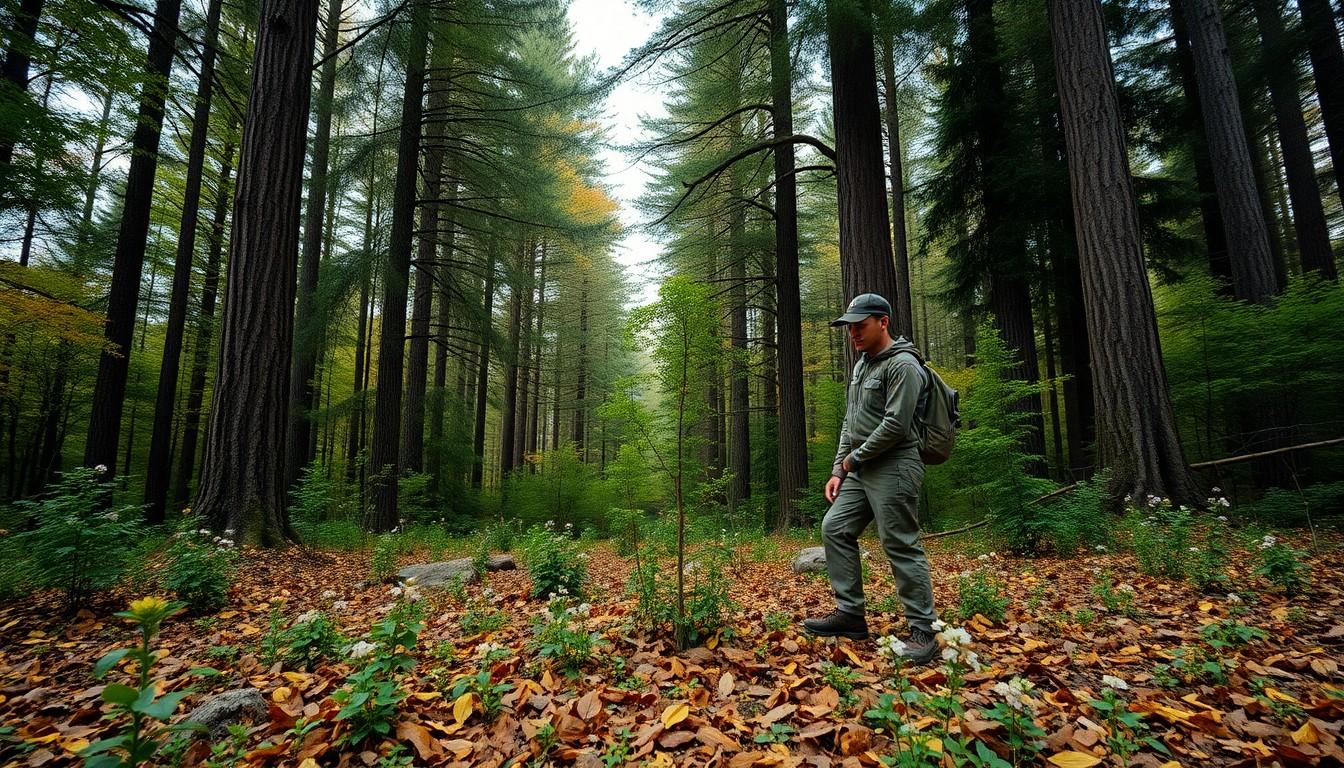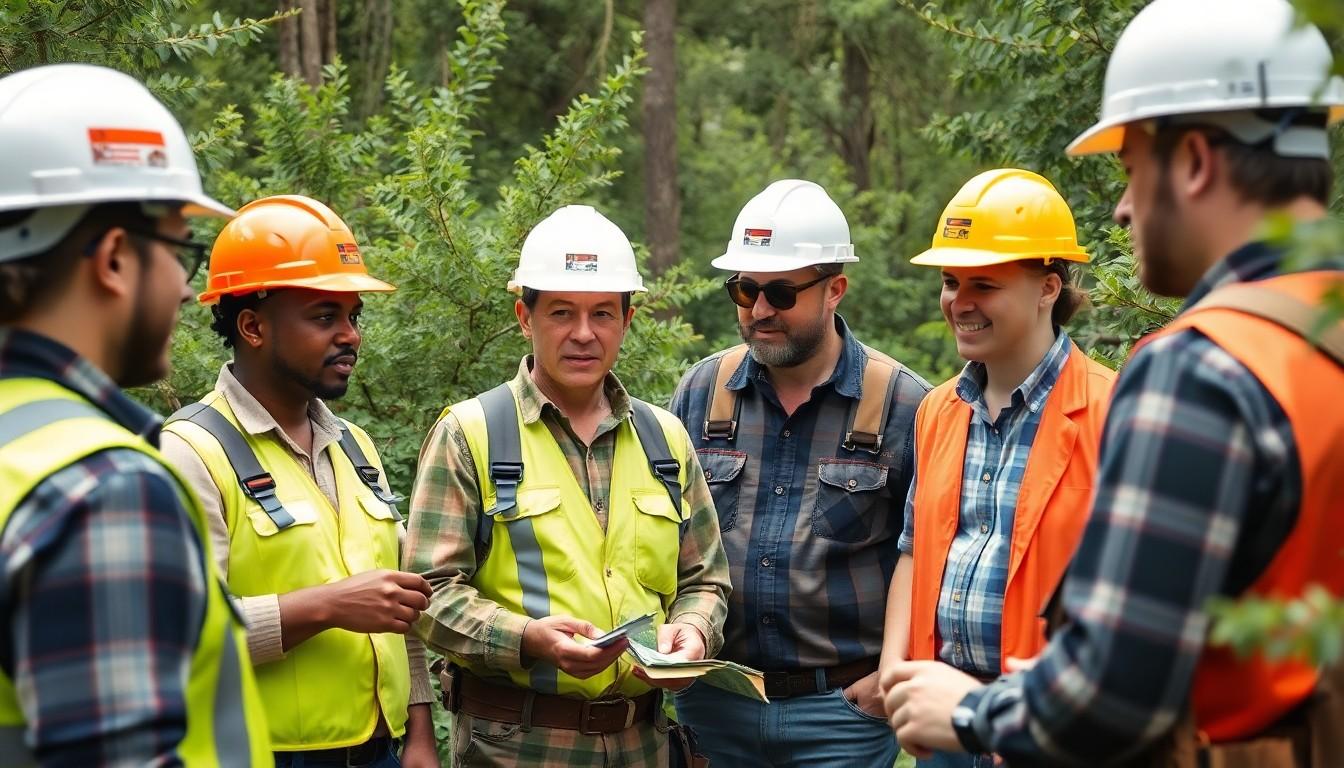In a world where trees are often treated like the background actors in a blockbuster film, conservation forestry steps into the spotlight. It’s not just about hugging trees or chanting “save the planet” while sipping organic coffee. This innovative approach combines sustainable practices with a dash of humor to keep our forests thriving. Imagine a woodland where trees grow tall and proud, while wildlife throws a party in the underbrush—now that’s a forest worth saving!
Conservation forestry isn’t just a noble cause; it’s a smart investment in our planet’s future. By balancing ecological health with economic needs, it ensures that the only thing getting logged is the bad jokes about lumberjacks. Join the movement and discover how this blend of science and stewardship can transform our relationship with nature, one tree at a time. After all, who wouldn’t want to be the hero in their own forest adventure?
Conservation Forestry
Conservation forestry combines sustainable practices with economic viability. This approach focuses on balancing ecological health while meeting human needs. Managing forests through conservation forestry promotes biodiversity, soil quality, and water conservation.
Key principles drive this methodology. First, it enhances forest health by maintaining diverse species of trees and other vegetation. Second, controlled logging practices are employed to minimize environmental impact. Third, it encourages partnerships with local communities for shared benefits. These collaborations often lead to responsible resource management.
The integration of science plays a crucial role. Techniques such as selective logging and reforestation bolster forest resilience. Researchers study forest ecosystems and their interactions, ensuring sustainable practices. Data from these studies informs land-use planning, allowing for better resource allocation.
Numerous organizations support conservation forestry initiatives. The Nature Conservancy and the World Wildlife Fund focus on sustainable forest management. Their programs promote conservation easements and offer financial incentives for landowners. This financial element serves to align economic interests with environmental stewardship.
Global climate change exacerbates the need for conservation forestry. Forests act as carbon sinks, absorbing significant amounts of CO2. By implementing effective conservation practices, the forestry sector can play an integral role in mitigating climate impact.
Community engagement remains vital in conservation forestry efforts. Educating local populations on sustainable practices fosters stewardship of forest resources. Such involvement ensures sustainable economic benefits while enhancing ecological integrity. In essence, conservation forestry embodies a holistic approach to forest management, aligning environmental, social, and economic goals.
Principles of Conservation Forestry

Conservation forestry operates on key principles that guide sustainable forest management. These principles ensure ecological health while addressing economic needs.
Sustainable Management Practices
Sustainable management practices form the backbone of conservation forestry. They incorporate techniques like selective logging and reduced impact logging. Each practice minimizes ecological disruption while maximizing resource efficiency. Regular assessments help land managers adapt practices based on current forest conditions. Tools such as forest management plans streamline operations, aligning economic goals with environmental stewardship. Stakeholder engagement forms a critical part of this process, fostering collaboration among landowners, government agencies, and local communities. Conservation easements provide legal frameworks to safeguard forest areas against unsustainable practices.
Biodiversity Conservation
Biodiversity conservation serves as a cornerstone in conservation forestry. Diverse species promote ecosystem resilience by enhancing habitat stability. Various tree and plant species support numerous wildlife populations, contributing to balanced ecosystems. When forests thrive through diversity, they maintain essential services like carbon sequestration and soil protection. Reforestation efforts target native species, ensuring that habitats remain intact for future generations. Partnerships with organizations like The Nature Conservancy help facilitate biodiversity projects, providing resources and expertise. Education initiatives raise awareness about the significance of biodiversity amongst local communities, reinforcing collective responsibility for natural resources.
Benefits of Conservation Forestry
Conservation forestry provides numerous benefits that enhance both the environment and the economy. This approach creates a symbiotic relationship between forest ecosystems and local communities.
Environmental Benefits
Maintaining biodiversity stands as a key advantage of conservation forestry. Diverse species bolster ecosystem resilience, supporting wildlife populations and facilitating essential services like carbon sequestration and soil protection. Promoting native species through reforestation preserves habitats while helping mitigate the effects of climate change. Forests function as crucial carbon sinks, absorbing significant amounts of CO2 and improving air quality. Improved soil health also results from diverse plant life, reducing erosion and promoting water retention. Organizations like The Nature Conservancy spearhead various biodiversity initiatives, raising awareness and driving local community engagement.
Economic Benefits
Conservation forestry contributes significantly to the economy by promoting sustainable practices. Local economies thrive through the implementation of selective logging, fostering job opportunities while reducing environmental impact. This approach balances resource extraction with forest health, ensuring long-term viability for the timber industry. Reduced impact logging minimizes disruption to ecosystems, enhancing forest productivity and stability. Engaging local communities encourages collaborative practices that align economic interests with ecological considerations. Additionally, sustainable management leads to increased market demand for responsibly sourced wood products, promoting a green economy. As a result, conservation forestry emerges as a viable investment in the future of both forests and communities.
Challenges in Conservation Forestry
Conservation forestry faces several significant challenges that hinder its effectiveness. Addressing these hurdles is crucial for promoting sustainable forest management.
Policy and Regulatory Hurdles
Complex policy frameworks impede progress in conservation forestry. Regulatory inconsistencies make it difficult for landowners to adopt sustainable practices. Moreover, outdated regulations often prioritize short-term economic gains over long-term ecological health. Communities engaged in conservation efforts encounter bureaucratic barriers that slow down projects. Collaboration among various stakeholders remains challenging due to conflicting interests. Hefty compliance costs decrease the likelihood of participation in conservation initiatives. Streamlining policies could enhance accessibility and encourage more stakeholders to engage in sustainable forestry.
Climate Change Impact
Climate change poses a serious threat to conservation forestry efforts. Changing weather patterns lead to increased tree mortality and pest outbreaks, jeopardizing forest health. Variability in precipitation affects species survival and habitat stability. Furthermore, rising temperatures escalate the risk of wildfires, destroying vital ecosystems. Forests previously viewed as carbon sinks now struggle to absorb carbon effectively. Addressing these impacts requires adaptive management strategies that consider future climate scenarios. Engaging local communities in resilience-building also helps strengthen efforts against climate-related challenges.
Case Studies in Conservation Forestry
Various case studies illustrate the successes and challenges in conservation forestry. Successful initiatives showcase effective practices and highlight the positive impact on both ecosystems and communities.
Successful Initiatives
Community-driven projects stand out as vital to conservation forestry. The Nature Conservancy’s efforts in the Pacific Northwest demonstrate how engaging local populations enhances biodiversity while ensuring sustainable resource management. An example is the collaboration with timber companies, which combines logging and conservation. This approach not only preserves vital habitats but also promotes responsible timber extraction, maintaining economic stability for local businesses. Educating communities about the importance of forest health has significantly improved stakeholders’ investment and commitment to conservation practices. Collaboration and shared goals have led to creating thriving ecosystems that benefit both wildlife and people.
Lessons Learned
Challenges in implementation provide valuable insights. Regulatory complexities often hinder effective conservation efforts. Learning from case studies shows that adaptive management techniques are essential in addressing these issues. Encouraging flexibility in policies can foster community engagement and participation, leading to shared ownership of forest resources. Communication between landowners and conservation organizations also plays a crucial role in success. Recognizing the need for ongoing education about sustainable practices helps align individual practices with collective goals. Through these experiences, stakeholders understand the importance of finding balance between ecological health and economic needs in forestry management.
Future Directions in Conservation Forestry
Emerging practices in conservation forestry emphasize adaptive management techniques. These techniques adjust to ongoing climate change impacts, ensuring forest resilience. Innovative methods, like agroforestry and mixed-species plantations, support enhanced biodiversity. Such approaches not only bolster ecosystem services but also provide economic returns to landowners.
Stakeholder collaboration remains pivotal for effective conservation forestry initiatives. Engaging local communities fosters stewardship and shared ownership of forest resources. Workshops and educational programs increase awareness of sustainable practices among diverse populations. Building partnerships with timber companies creates mutually beneficial arrangements that promote environmental responsibility.
Technological advancements play a crucial role in the future of conservation forestry. Remote sensing tools and GIS technology enhance forest monitoring capabilities. Data-driven decision-making empowers land managers to create precise and effective management plans. Integrated software systems enable tracking of logging activities, ensuring compliance with conservation standards.
Policymakers must streamline regulations to reduce bureaucratic barriers that hinder progress. Simplifying approval processes accelerates the adoption of sustainable practices among landowners. Emphasizing long-term ecological health over short-term economic gains can enhance the effectiveness of conservation efforts.
Investment in research and development further strengthens conservation forestry. Studying the impacts of different management strategies helps refine practices. Engaging in experimental projects offers insights into successful integrations of conservation with sustainable techniques.
Ultimately, the future of conservation forestry hinges on collaboration, innovation, and adaptability. Creating thriving ecosystems while supporting local economies remains a shared priority, driving the movement toward a sustainable future. Embracing these future directions strengthens both forests and the communities that depend on them.
Balancing Ecological Integrity With Economic Viability
Conservation forestry stands as a crucial strategy for balancing ecological integrity with economic viability. By fostering biodiversity and engaging local communities, it creates a sustainable future for forests and the people who rely on them. The challenges facing this approach underscore the need for adaptive management and streamlined policies to encourage participation and innovation.
As the world grapples with climate change, the importance of conservation forestry only intensifies. It’s not just about preserving trees; it’s about ensuring a resilient ecosystem that supports both wildlife and human livelihoods. Embracing collaborative practices and investing in research will pave the way for thriving forests that endure for generations to come.

